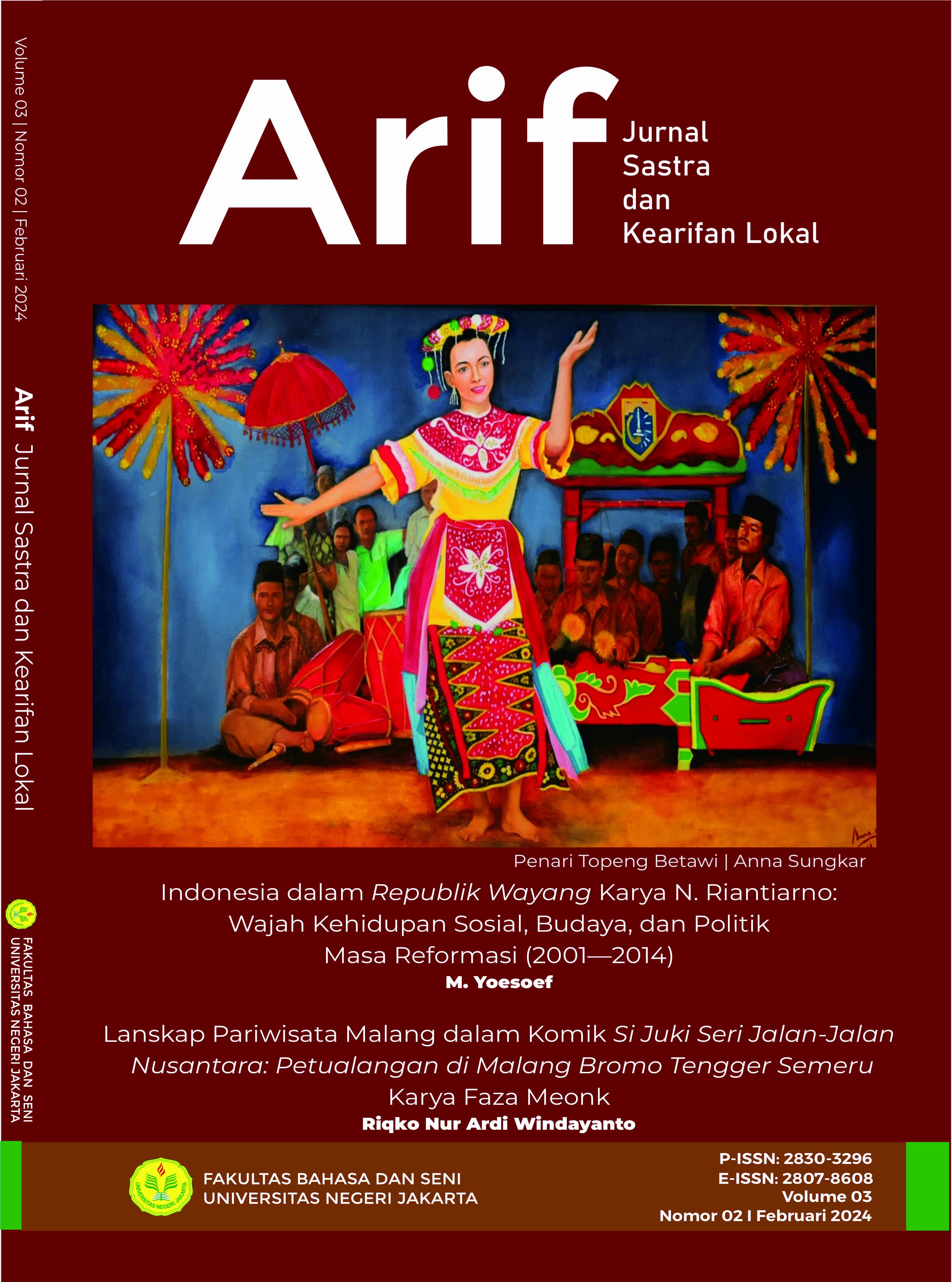Covid-19 dalam Fiksi Mini Indonesia
DOI:
https://doi.org/10.21009/Arif.032.06Keywords:
covid, fiksi mini, budaya, IndonesiaAbstract
ujuan penelitian ini adalah menemukan prespektif budaya masyarakat Indonesia saat menghadapi covid-19 melalui fiksi mini. Metode penelitian ini adalah metode penelitian kualitatif dengan pendekatan fenomenologi hermeneutik. Sumber data dalam penelitian ini adalah sastra wabah Indonesia berjudul kumpulan fiksi mini berjudul Sepersejutamilimeter dari Corona. Data dianalisis dengan prespektif budaya dan teknik analisis hipotesis Shapir Whorf. Penelitian ini menghasilkan temuan berupa (1) heterogenitas karya dalam sastra wabah berjudul Sepersejutamilimeter dari Corona, (2) representasi bahasa, (3) representasi pikiran, dan (4) representasi budaya. Hasil penelitian menunjukkan bahwa masyarakat Indonesia merindukan rumah, khususnya keselrasan dalam keluarga sebagai solusi saat menghadapi pandemi Covid-19. Hal ini dipengaruhi oleh prespektif budaya masyarakat Indonesia yang menganggap keluarga sebagai pondasi keselarasan. Keselarasan keluarga merupakan keselarasan mikrokosmos yang diharapkan dapat memicu keselarasan masyarakat, atau keselarasan makrokosmos. Covid-19 dapat diselesaikan apabila terdapat keselarasan alam dan manusia
References
Afnan, D. (2022). Mitos Larangan Menikah antara Orang Jawa dengan Orang Sunda dalam Perspektif Masyarakat Modern. Arif: Jurnal Sastra Dan Kearifan Lokal, 2(1), 157–176.
Alesina, A., & Giuliano, P. (2015). Culture and institutions. Journal of Economic Literature, 53(4), 898–944.
Al-Sharqi, L., & Abbasi, I. S. (2015). Flash fiction: A unique writer-reader partnership. Studies in Literature and Language, 11(1), 52–56.
Banda, M. M. (2023). Diskursus Keindonesiaan dalam Tonil “Rahasia Kelimutu” Karya Bung Karno: Alih Wahana dari Mitos Danau Kelimutu. Arif: Jurnal Sastra Dan Kearifan Lokal, 2(2), 229–248.
Barr, L. (2010). Short, shorter, shortest stories by Shua. JSTOR.
Barthes, R. (1968). Elements of semiology. Macmillan.
Barthes, R. (1977). Elements of semiology (Vol. 4). Macmillan.
Batchelor, K. E., & King, A. (2014). Freshmen and five hundred words: Investigating flash fiction as a genre for high school writing. Journal of Adolescent & Adult Literacy, 58(2), 111–121.
Bennett, T., Grossberg, L., & Morris, M. (2013). New keywords: A revised vocabulary of culture and society. John Wiley & Sons.
Ben-Porat, Z. (2011a). From flash fiction to nano-literature or what can be learned from 6 word long micro-stories. Atas Do Simpósio Internacional “Microcontos e Outras Microformas”. Centro de Estudos Humanísticos. Universidade Do Minho, Braga, Portugal.
Ben-Porat, Z. (2011b). From flash fiction to nano-literature or what can be learned from 6 word long micro-stories. Atas Do Simpósio Internacional “Microcontos e Outras Microformas”. Centro de Estudos Humanísticos. Universidade Do Minho, Braga, Portugal.
Casto, P. (2015). Flashes on the meridian: Dazzled by flash fiction. Riding the Meridian, Ed. Jennifer Ley, 1(2), 13.
Chaer, A. (2003). Psikolinguistik: kajian teoretik. Rineka Cipta.
Chomsky, N. (2006). Language and mind. Cambridge University Press.
Clark, H. H., & Clark, E. V. (1977). Psychology and language.
Colletta, N. J., & Kayam, U. (1987). Kebudayaan dan pembangunan: sebuah pendekatan terhadap antropologi terapan di Indonesia. (No Title).
Creswell, J. W., & Poth, C. N. (2016). Qualitative inquiry and research design: Choosing among five approaches. Sage publications.
Crum, M. (2017). Twitter Fiction Reveals The Power Of Very, Very Short Stories. The Huffington Post.
Deopa, N., & Fortunato, P. (2022). Language and the cultural markers of COVID-19. Social Science & Medicine, 301, 114886.
Durante, R., Guiso, L., & Gulino, G. (2021). Asocial capital: Civic culture and social distancing during COVID-19. Journal of Public Economics, 194, 104342.
Egger, P. H., & Lassmann, A. (2015). The causal impact of common native language on international trade: Evidence from a spatial regression discontinuity design. The Economic Journal, 125(584), 699–745.
Endraswara, S. (2008). Metode penelitian psikologi sastra: Teori, langkah dan penerapannya. Media Pressindo.
Epp, M. (2022). Physical and Figural Animals in Patrick Deville’s Peste & Choléra. Neophilologus, 1–14.
Essebo, M. (2022). Storying COVID-19: fear, digitalisation, and the transformational potential of storytelling. Sustainability Science, 17(2), 555–564.
Estok, S. C. (2021). Camus, Roth, Covid-19: the dangers of forgetting. Neohelicon, 48, 503–514.
Eugster, B., Lalive, R., Steinhauer, A., & Zweimüller, J. (2011). The demand for social insurance: does culture matter? The Economic Journal, 121(556), F413–F448.
Ferguson, J. (2010). Border markers.
Geertz, C. (1983). Abangan, santri, priyayi: dalam masyarakat Jawa (Issue 4). Pustaka Jaya.
Georgakopoulou, A. (2007). Small stories, interaction and identities (Vol. 8). John Benjamins Publishing.
Greenshields, W. (2021). “Christianity is an epidemic”: on Hölderlin and the plague. Neohelicon, 48, 477–492.
Guimaraes, J. F. (2009). The short-short story: The problem of literary genre. International Symposium on Genre Studies, Caxias Do Sul, Brazil. Paper Retrieved from Http://Www. Ucs. Br/Ucs/TplSiget/Extensao/Agenda/Eventos/Vsiget/Portugues/Anais/Te Xtos Autor/Arquivos/the Short Short Story the Problem of Literary Genre. Pdf.
Guiso, L., Sapienza, P., & Zingales, L. (2006). Does culture affect economic outcomes? Journal of Economic Perspectives, 20(2), 23–48.
Hall, S. (2006). Cultural studies and its theoretical legacies. In Stuart Hall (pp. 272–285). Routledge.
Halliday, M. A. K. (2009). Methods–techniques–problems. Continuum Companion to Systemic Functional Linguistics, 59–86.
Herawati, T., Krisnatuti, D., Pujihasvuty, R., & Latifah, E. W. (2020). Faktor-faktor yang memengaruhi pelaksanaan fungsi keluarga di Indonesia. Jurnal Ilmu Keluarga & Konsumen, 13(3), 213–227.
Hoijer, H. E. (1954). Language in culture; conference on the interrelations of language and other aspects of culture.
HUMBOLDT, W. Von. (n.d.). Linguistic variability and intelectual development (traducción inglesa de GC Buck y FA Raven). Philadelphia, University of Pennsylvania Press,[1836].
Hussein, B. A.-S. (2012). The sapir-whorf hypothesis today. Theory and Practice in Language Studies, 2(3), 642–646.
Jayanti, C. T. (2017). Wacana fiki mini bahasa Indonesia: Analisis struktur, keterpaduan, permainan bahasa, dan fungsi. Bahasa Dan Seni: Jurnal Bahasa, Sastra, Seni, Dan Pengajarannya, 44(2), 175–187.
Koentjaraningrat. (1987). Anthropology in Indonesia. Journal of Southeast Asian Studies, 217–234.
Leak, A. N. (1994). Barthes: mythologies. Grant and Cutler.
Lenneberg, E. H. (1964). New directions in the study of language.
Lombart, D. (2008). Nusa Jawa: Silang Budaya Kajian Sejarah Terpadu, Bagian I: Batas-Balas Pembaratan.
Lucht, B. (2014). Flash Fiction: Literary fast food or a metamodern (sub) genre with potential. 2nd Human And Social Sciences at the Common Conference, 17–21.
Lukin, A. (2017). Ideology and the text-in-context relation. Functional Linguistics, 4(1), 1–17.
Magnis-Suseno, F. (1984). Etika jawa. Sebuah Analisa Falsafi Tentang Kebijaksanaan Hidup Jawa. Jakarta: PT. Gramedia.
Masih, T. L. (2009). Field guide to writing flash fiction: Tips from editors, teachers, and writers in the field. Rose Metal Press.
Meisenberg, B. R. (2021). “Heroism”“duty” and “decency” in pandemic medicine: lessons from Camus on fighting plagues. Journal of General Internal Medicine, 1–2.
Minderop, A. (2010). Psikologi sastra: karya, metode, teori, dan contoh kasus. Yayasan Pustaka Obor Indonesia.
Moruzi, K., Chen, S. W. S., & Venzo, P. (2022). Public Health, Polio, and Pandemics: Fear and Anxiety about Health in Children’s Literature. Children’s Literature in Education, 53(1), 97–111. https://doi.org/10.1007/s10583-021-09439-8
Mousavi, M., & Mousavi, S. M. A. (2014). Flash Fiction, Defamiliarization and Cultural Criticism: A Case Study of. Salahshoor‟ s Please Smile. International Journal of Humanities and Social Science, 4(7), 1.
Mukid, A. dkk. (2020). Sepersejuta Milimeter dari Corona (T. Thajono, Ed.). Tankali.
Mulder, N. (1985). Pribadi dan masyarakat di Jawa: penjelajahan mengenai hubungannya, Yogyakarta, 1970-1980. (No Title).
Nelles, W. (2012). Microfiction: What makes a very short story very short? Narrative, 20(1), 87–104.
Nurfajrin, D. (2023). Tradisi Lisan Ngabeluk pada Masyarakat Sunda: Hegemoni dan Representasi Identitas. Arif: Jurnal Sastra Dan Kearifan Lokal, 3(1), 24–42.
Omar, A., Ibrahim Elghayesh, B., & Ali Mohamed Kassem, M. (2019). Authorship attribution revisited: The problem of flash fiction a morphological-based linguistic stylometry approach. Arab World English Journal (AWEJ) Volume, 10.
Piaget, J. (2005). Language and Thought of the Child: Selected Works vol 5. Routledge.
Plager, K. (1994). Hermeneutic phenomenology. Interpretive Phenomenology: Embodiment, Caring, and Ethics in Health and Illness, 65–83.
Reaske, C. R. (1966). How to analyze poetry. (No Title).
Rokib, M. (2022). Gerak komunitas fiki mini di ruang siber. International Joint Conference on Arts and Humanities.
Sapir, E. (1929). The status of linguistics as a science. Language, 207–214.
Saputra, A. W. (2021). Ekspresi Kultural Masyarakat Mejayan Menghadapi Pandemi dalam Cerpen “Dongkrek” Karya Hendy Pratama: Perspektif Antropologi Sastra. Arif: Jurnal Sastra Dan Kearifan Lokal, 1(1), 99–113.
Saputra, A. W., & Meilasari, P. (2020a). Pentigraf sebagai inovasi pembelajaran sejarah pada masyarakat era disrupsi. KEMBARA: Jurnal Keilmuan Bahasa, Sastra, Dan Pengajarannya, 6(2), 131–141.
Saputra, A. W., & Meilasari, P. (2020b). Resonansi kampung pentigraf sebagai komunitas sastra 4.0 Indonesia. Jurnal Ilmiah FONEMA: Jurnal Edukasi Bahasa Dan Sastra Indonesia, 3(2), 82–98.
Sari, A. V., & Wiyatmi, W. (2021). Sexual Politics in Fiki mini: Analysis of Feminist Critical Discourse. International Journal of Linguistics, Literature and Translation, 4(2), 111–119.
Saryono, D. (2011). Sosok nilai budaya Jawa: rekonstruksi normatif-idealistis. Aditya Media Publishing, 2011.
Shapard, R., & Thomas, J. (2007). New sudden fiction: Short-short stories from America and beyond. (No Title).
Shofa, A. M. A., & Saputra, A. W. (2021). National pentigraf as citizenship education innovation for millennial generations. In Empowering Civil Society in the Industrial Revolution 4.0 (pp. 158–162). Routledge. https://doi.org/10.1201/9781003180128-30
Tarrayo, V. N. (2018). Beauty in Brevity: Capturing the Narrative Structure of Flash Fiction by Filipino Writers. Journal on English Language Teaching, 8(2), 36–56.
Thomas, L., & Wareing, S. (2004). Language, society and power: An introduction. Routledge.
Tjahjono, T. (2018). Meneroka dapur pentigraf: Ke arah kegiatan apresiasi tiga paragraf. Penerbit Delima.
Tjahjono, T. (2020). Berumah dalam Sastra Tiga. Tankali.
Whorf, B. (1946). The Hopi language, Toreva dialect. Linguistic Structures of Native America, ed. by H. Hoijer, 158–183. New York: The Viking Fund. Inc.
Whorf, B. L. (1956). Language, thought, and reality: selected writings of….(Edited by John B. Carroll.).












